Your browser does not fully support modern features. Please upgrade for a smoother experience.

Submitted Successfully!
Thank you for your contribution! You can also upload a video entry or images related to this topic.
For video creation, please contact our Academic Video Service.
| Version | Summary | Created by | Modification | Content Size | Created at | Operation |
|---|---|---|---|---|---|---|
| 1 | Hamdy Ibrahim | -- | 1859 | 2023-02-22 15:20:24 | | | |
| 2 | Jason Zhu | -3 word(s) | 1856 | 2023-02-23 03:30:44 | | |
Video Upload Options
We provide professional Academic Video Service to translate complex research into visually appealing presentations. Would you like to try it?
Cite
If you have any further questions, please contact Encyclopedia Editorial Office.
Ammar, Z.; Ibrahim, H.; Adly, M.; Sarris, I.; Mehanny, S. Natural Fiber in Frictional Material of Brake Pads. Encyclopedia. Available online: https://encyclopedia.pub/entry/41548 (accessed on 13 January 2026).
Ammar Z, Ibrahim H, Adly M, Sarris I, Mehanny S. Natural Fiber in Frictional Material of Brake Pads. Encyclopedia. Available at: https://encyclopedia.pub/entry/41548. Accessed January 13, 2026.
Ammar, Zeina, Hamdy Ibrahim, Mahmoud Adly, Ioannis Sarris, Sherif Mehanny. "Natural Fiber in Frictional Material of Brake Pads" Encyclopedia, https://encyclopedia.pub/entry/41548 (accessed January 13, 2026).
Ammar, Z., Ibrahim, H., Adly, M., Sarris, I., & Mehanny, S. (2023, February 22). Natural Fiber in Frictional Material of Brake Pads. In Encyclopedia. https://encyclopedia.pub/entry/41548
Ammar, Zeina, et al. "Natural Fiber in Frictional Material of Brake Pads." Encyclopedia. Web. 22 February, 2023.
Copy Citation
Research into the use of eco-friendly materials, such as natural fibers, in brake pads has gained momentum. This can be attributed to the potential of natural fibers to replace traditional materials in tribological applications such as braking pads. The harmful impact of commonly-used brake pad materials, such as metal and mineral fibers, on human health and the environment, necessitates the development of eco-friendly alternatives. Natural fibers, such as banana peels, palm kernels, and palm slag, have been shown to be viable replacements for traditional brake pad materials.
brake pads
natural fiber
life-cycle assessment
1. Introduction
The braking system is one of the crucial systems in automobiles, responsible for slowing down or stopping the automobile by converting kinetic energy to thermal energy through friction. For this reason, it is important for brake pads to have a high and stable coefficient of friction [1]. This makes the selection of the appropriate friction material for brake pads of paramount importance and much research has been dedicated to the process of selecting and developing new friction materials. Factors considered in the process of selecting friction materials include the manufacturing process and material requirements. Generally, friction materials can be classified into three categories [2]: (i) metallic brake linings, (ii) carbon−carbon composites, and (iii) organic polymerics (resin bonded).
Metallic brake linings, made of iron or copper, are commonly used in heavyweight and high-speed aircraft, as well as high-speed trains. This is mainly due to the high thermal stability of metallic brake linings, which is a necessary characteristic for these types of applications [3]. Despite their ease of fabrication and low cost, metallic brake linings have a high density, which decreases the system’s energy efficiency [2].
The carbon−carbon composite friction materials are primarily utilized in aircraft applications. They are 40% lighter in weight than metallic brake linings and have a high strength at elevated temperatures, twice that of steel. This allows them to have a longer service life. However, the main limitations of carbon−carbon composite materials are their high cost and susceptibility to oxidation [2].
On the other hand, organic polymerics are used in the production of light-duty brakes that are commonly used in normal clutches. Organic polymerics typically consist of 30–40% organic resin, with a wide range of ingredients and formulations. There are four main categories of components used to create organic polymeric materials: binders, fillers, friction modifiers, and reinforcements [2]. As a result, selecting the appropriate organic polymeric friction material needed for a specific application can be a challenging task.
2. Formulation and Manufacturing Process
Several studies have reported that natural fiber-reinforced composite (NFRC) materials showed better tribological and mechanical properties [4][5][6][7][8][9][10][11][12][13][14][15][16][17][18][19][20][21][22][23][24][25][26][27][28]. These studies also showed the effect of the adhesion between the ingredients and how that affects the mechanical and tribological properties.
One of the factors that influences the adhesion of fibers is the alkaline treatment applied to them. This treatment is utilized to remove the unwanted elements, such as impurities, from the fiber [29]. The alkali treatment is a cleaning and modifying treatment for the surface of fibers to reduce surface tension and enhance the interfacial adhesion of natural fibers [30][31].
3. Influence of Natural Fiber on the Mechanical and Tribological Properties
When natural fibers are used as reinforcement elements, the tribological properties can be improved by controlling the fiber content at certain levels [4][5][6][7][8][9][10][11][12][13][14][15][16][17][18][19][20][21][22][23][24][25][26][27][28]. The natural fiber content affects the tribological properties, mainly due to the change in the binder (matrix) to the natural fiber ratio. The binder to the natural fiber ratio affects the adhesion force, which has a direct influence on the tribological properties [32]. The use of natural fibers improves the mechanical properties until a certain point, then the mechanical properties start to decrease. This could be observed for banana fiber and palm kernel fibers with different ingredients and different weight percentage of the fibers. For instance, when this ratio is below an optimum value, the fiber content needed to reinforce the matrix is not enough. In addition, when it is above that optimum value, the fibers will need more binder to bind together. Hence, the deterioration of mechanical and tribological properties is expected in cases when the fiber content is above or below these optimum values.
Researchers have focused their efforts on measuring different mechanical and tribological properties of natural fiber composite materials that are prepared by using various binders and natural fiber types and contents. They also measured the porosity, density, hardness, thermal conductivity, compressibility, wear rate, and coefficient of friction (COF) of the prepared composites. Figure 1 and Figure 2 show the testing machines (T-Mc) and standard (St) used by some of the studies to determine the tribological properties. These properties are illustrated Figure 3, Figure 4, Figure 5, Figure 6 and Figure 7.
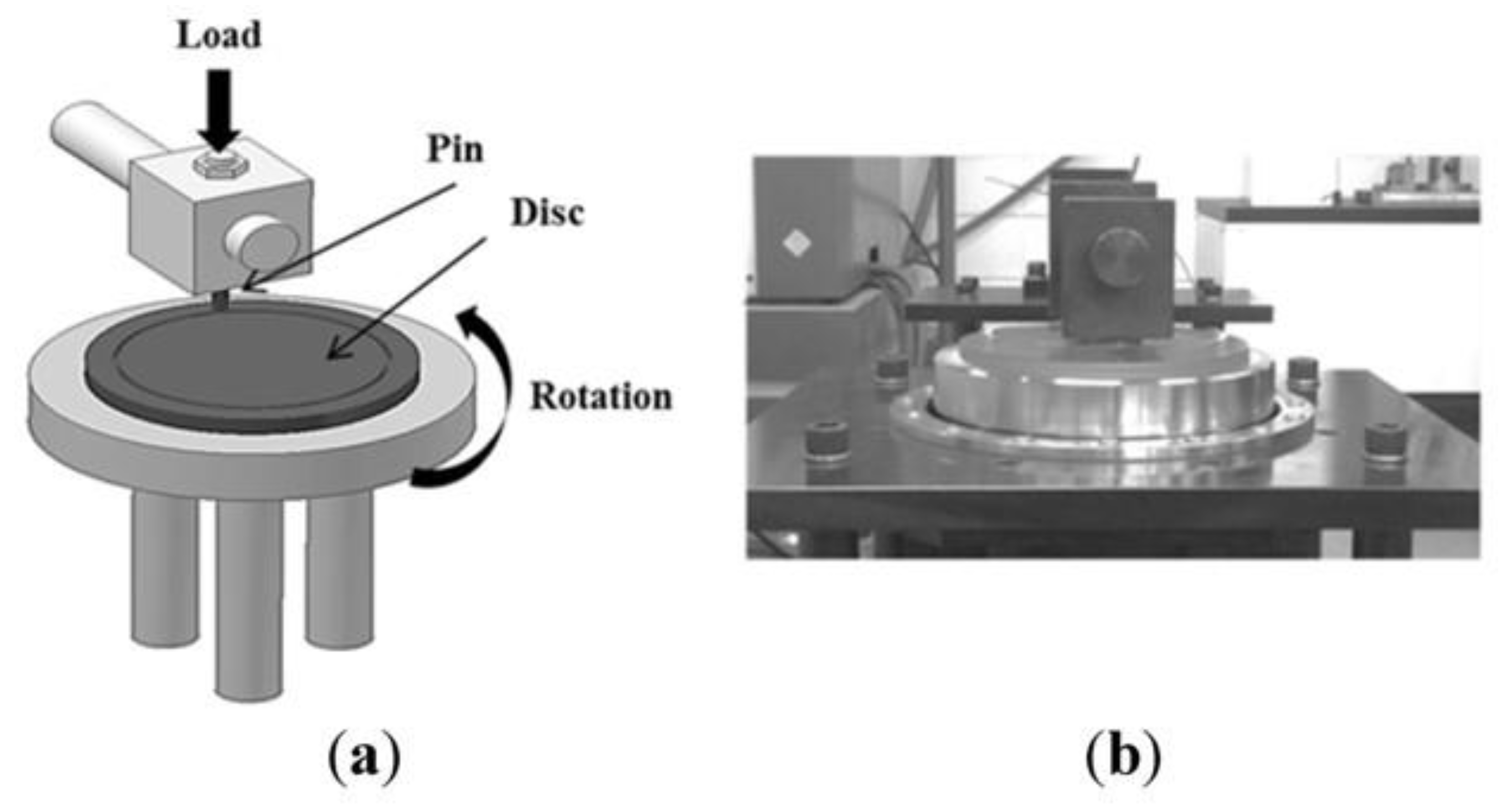
Figure 1. (a) The schematic of the pin-on-disc machine and (b) pin-on-disc used in the wear rate and measuring COF [33].
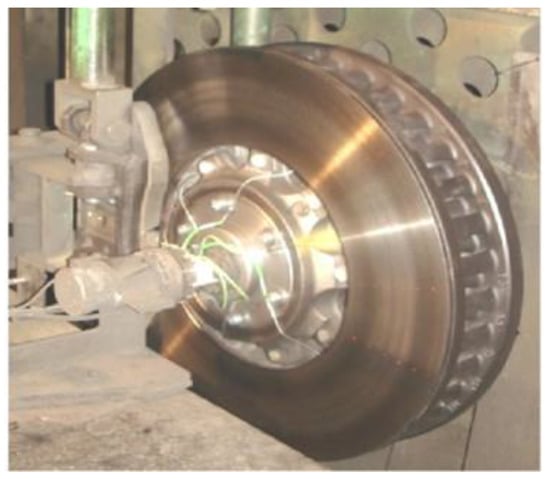
Figure 2. The disc brake machine used for measuring the wear rate and COF [34].
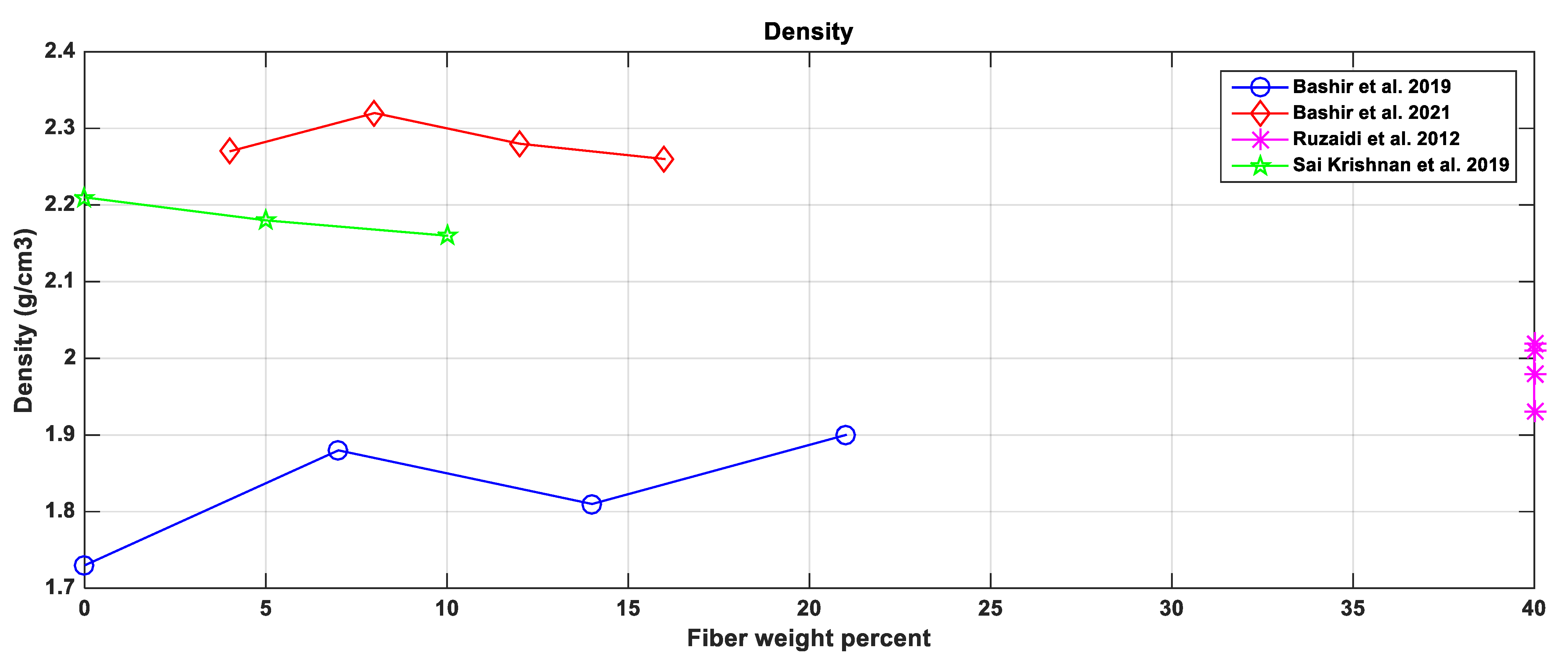

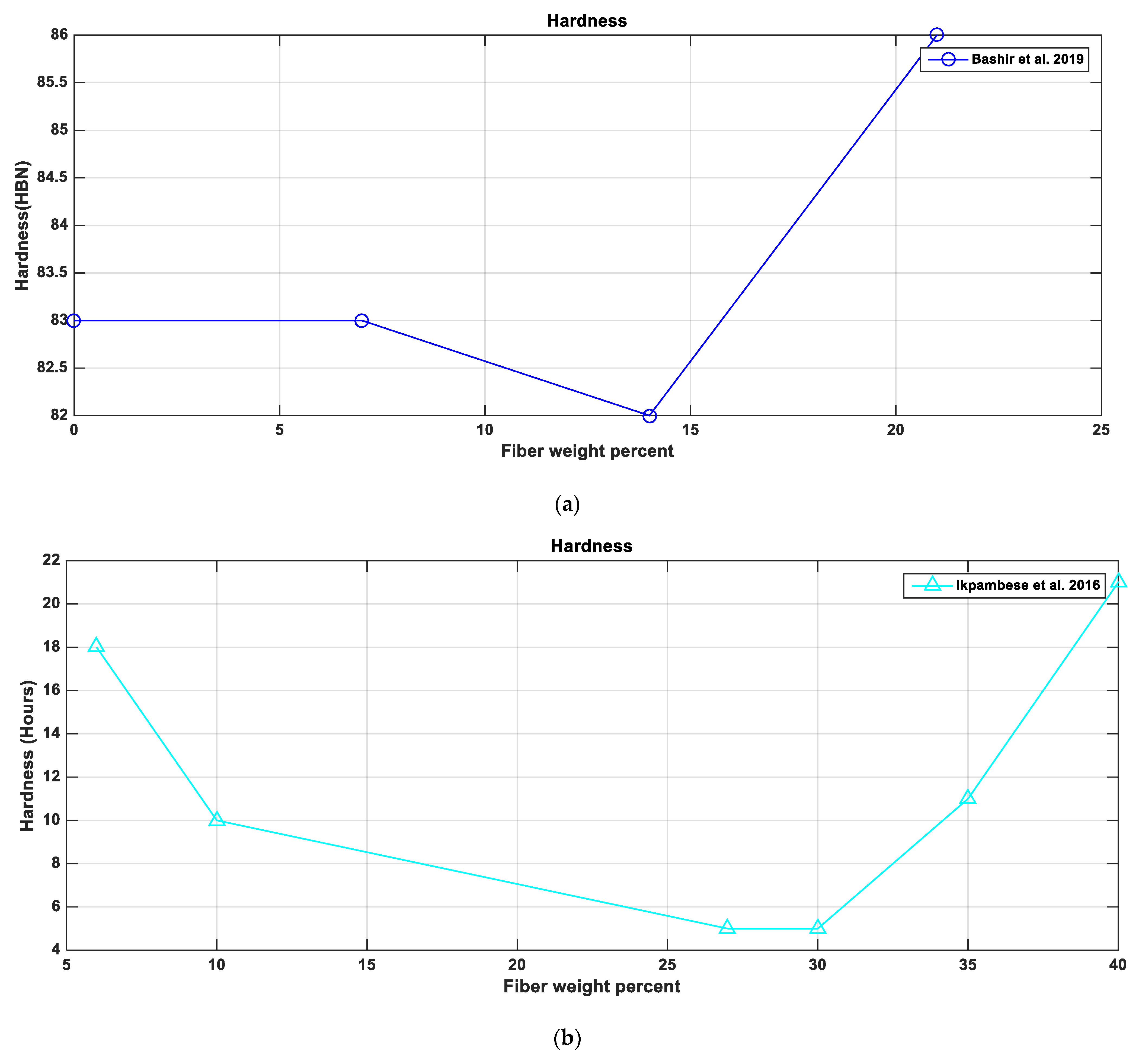

Figure 5. (a) The variation of hardness using the Brinell tester for banana fiber with variation in the fiber weight percentage [4], (b) illustrates variation of hardness using inertia dynamotor palm kernel fiber with variation in the fiber weight percentage [17], and (c) variation of hardness using Rockwell tester for different fibers with a variation in the fiber weight percentage [5][18][23][28].
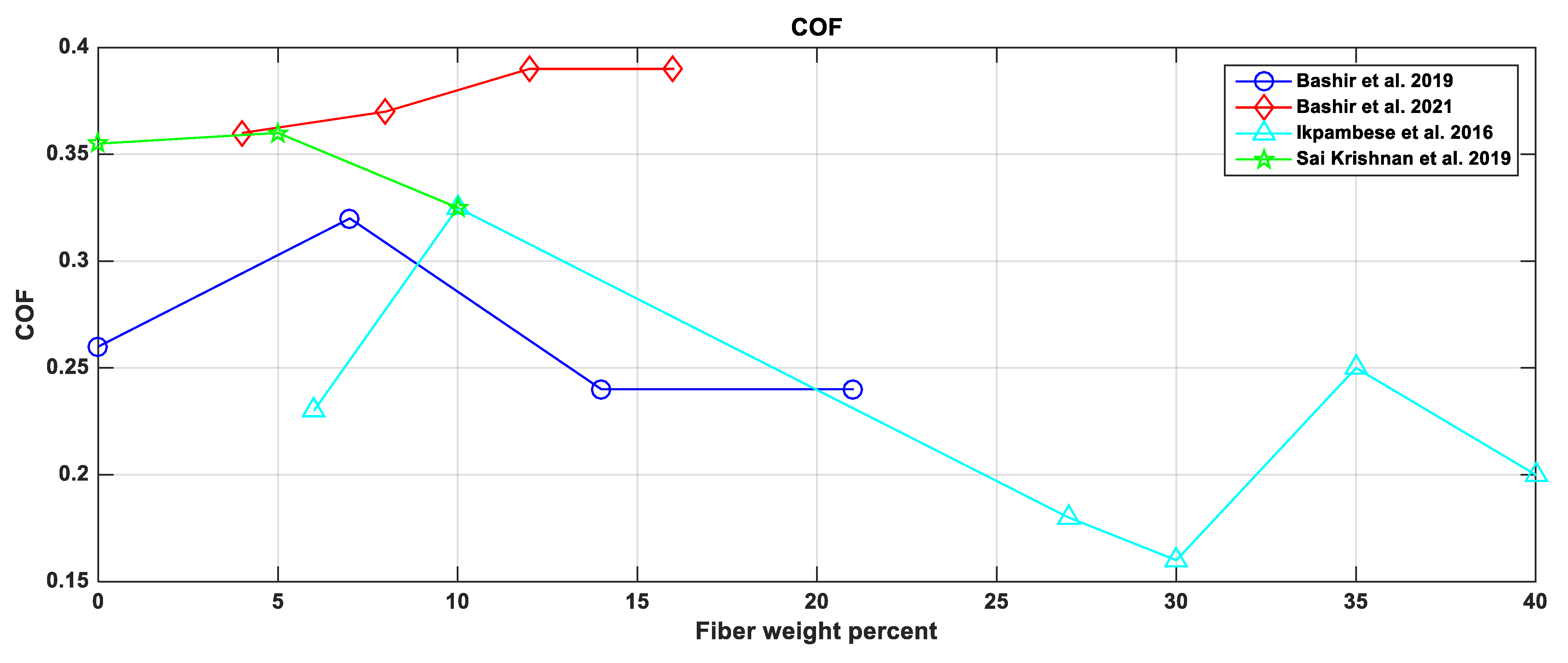


Figure 7. (a) The variation of wear rate for different fibers for different fiber weight percentages in mg/m [17], (b) the variation of wear rate for different fibers for different fiber weight percentage in mm3/Nm [5][18], (c) and the variation of wear rate for different fibers for different fiber weight percentage in g [4][23].
In order to provide better comparative observations of the effect of these natural fiber types and their contents on the resulting properties, the results obtained by other researchers are plotted, as shown in Figure 3, Figure 4, Figure 5, Figure 6 and Figure 7. For example, palm kernel fibers [23] show values of wear rate and hardness, as the fiber content is constant while the pressure used during manufacture varies from 10 to 60 tons. In addition, the inverse relationship between the density and the porosity is quite clear when examining Figure 3 and Figure 4. Moreover, the density increased for banana fiber weight percentages (Wt.%) of 63% and 82% parent matrices, until reaching a certain fiber weight percentage before decreasing. However, the density of the 63 Wt.% composite increased again after the decrease happened at the 14% Wt.% fiber content. Palm kernel with a 54% Wt.% fiber content recorded a density drop when the fiber weight percentage increased. This drop could be due to the change in fillers and the friction modifier MoS4 used (Figure 3).
There was a boosting up trend for porosity percentage in the palm kernel of 46% in the parent matrix. It could be observed that the enlargement of the porosity decreased the density value, which could be referred to as the particle size of the palm kernel fibers [17]. This could be attributed to the fact that the particle size of the palm kernel fibers was higher than that of the space filler used [28]. The uniform curing caused a uniform dispersion, which led to a high porosity value [28] (Figure 4). Furthermore, the measured hardness improved for all of the tested natural fiber composites. This improvement was observed to occur with the fiber weight percent rising, except for the case of palm kernel with the 46% parent matrix. The hardness value of each formulation was quite close to the other one and this could be due to applying the same pressure and temperature for the same duration during the hot compaction process [4]. In addition, this rise could be attributed to the cross-linking between the fiber and the resin that takes place during the curing process [5] (Figure 5a). The hardness of the palm kernel with the 46% parent matrix decrease is suggested to occur because of the increase in porosity as the fiber weight percent increased (Figure 5c). The palm kernel of the [17] hardness decayed as the fiber weight percent increased, followed by a jump at 35 and 40% fiber weight percent (Figure 5b). The hardness values of the palm kernel 40% fiber weight percent showed an increase as the compression force used in the fabrication process increased. Increasing the pressure had a role in reducing the voids in the NFRC-based composites. The effect of having a compact and composite material, with a high density and low porosity, is known to improve the mechanical properties significantly [4].
The tribological properties recorded an obvious improvement as the fiber weight percentage increased. Most formulations recorded a trend for enhancement of the properties. The banana fibers recorded a trend of increasing the COF among all of the formulations, except that of the 63% parent matrix (Figure 6). The COF in Figure 6 is the average value for banana fibers [4][5] as it was examined at different temperatures and different loads.
The wear rate in Figure 7 is the average value for the results from several studies [4][5][17][18][23]. An average value was used because of the differences in the testing conditions. The 63% parent matrix recorded an increase followed by a drop, then stability for the COF value. This drop could be due to the failure of bonding between the phenolic resin and the banana fibers. Moreover, it is an indication of the deteriorated COF for these composites at elevated temperatures [4]. The palm kernel fibers recorded a different COF trend, which is obvious in the graphs. The 46% parent matrix recorded a slight increase followed by a minor drop. This could be attributed to the degradation of the palm kernel fiber at higher temperatures [28]. Ikpambese et al. [17] recorded a decreasing trend followed by an overshot trend, which seems to be different that the results reported in other similar studies. However, this difference could be attributed to the change in the natural fiber weight percent, the absence of a parent matrix, and variations in the ingredients. Furthermore, the results seem to be stable at different ranges, which could be due to the absence of steel fiber [17], as steel fibers play a role in increasing the COF [5][18][35][36].
In general, the wear rate showed trends for both banana and palm kernel. Some of them increased with increasing the fiber weight percent, while others showed a decreasing trend after an initial increase. In addition, some of them showed an increase followed by a decrease and then another increase (Figure 7). For example, the banana fibers with a 63% and 82% parent matrix showed an increase in wear rate as the fiber weight percent increased. This boost could be due to the degradation of the samples at elevated temperatures [4] (Figure 7b,c). Finally, studies that showed an increase followed by a decrease and then an increase were that of palm kernel fiber weight percentages of 5–25% and phenolic resin of 35% weight percent. This could be attributed to the unique adhesion properties between the wheat and Nile rose with the phenolic resin. The formulation that did not contain the Nile rose and wheat showed better results at the same fiber weight percentage, and followed a trend of increasing followed by decreasing, as better wear resistance was obtained through the strong adhesion of natural fibers with resin [32].
References
- Tarr, W.; Rhee, S. Static friction of automotive friction materials. Wear 1975, 33, 373–375.
- Bijwe, J. Composites as friction materials: Recent developments in non-asbestos fiber reinforced friction materials? A review. Polym. Compos. 1997, 18, 378–396.
- Tsang, P.; Jacko, M.; Rhee, S. Comparison of Chase and inertial brake Dynamometer testing of automotive friction materials. Wear 1985, 103, 217–232.
- Bashir, M.; Qayoum, A.; Saleem, S.S. Influence of lignocellulosic banana fiber on the thermal stability of brake pad material. Mater. Res. Express 2019, 6, 115551.
- Bashir, M.; Qayoum, A.; Saleem, S.S. Experimental Investigation of Thermal and Tribological Characteristics of Brake Pad Developed from Eco-Friendly Materials. J. Bio- Tribo-Corrosion 2021, 7, 66.
- Kholil, A.; Dwiyati, S.T.; Wirawan, R.; Elvin, M. Brake Pad Characteristics of Natural Fiber Composites from Coconut Fibre and Wood Powder. J. Phys. Conf. Ser. 2021, 2019, 012068.
- Sutikno; Pramujati, B.; Safitri, S.D.; Razitania, A. Characteristics of natural fiber reinforced composite for brake pads material. AIP Conf. Proc. 2018, 1983, 050009.
- Kholil, A.; Dwiyati, S.T.; Sugiharto, A.; Sugita, I.W. Characteristics composite of wood powder, coconut fiber and green mussel shell for electric motorcycle brake pads. J. Phys. Conf. Ser. 2019, 1402, 055095.
- Singh, T.; Pruncu, C.I.; Gangil, B.; Singh, V.; Fekete, G. Comparative performance assessment of pineapple and Kevlar fibers based friction composites. J. Mater. Res. Technol. 2020, 9, 1491–1499.
- Craciun, A.L.; Pinca-Bretotean, C.; Utu, I.-D.; Josan, A. Tribological properties of nonasbestos brake pad material by using coconut fiber. IOP Conf. Ser. Mater. Sci. Eng. 2017, 163, 12014.
- Maleque, M.A.; Atiqah, A. Development and Characterization of Coir Fibre Reinforced Composite Brake Friction Materials. Arab. J. Sci. Eng. 2013, 38, 3191–3199.
- Fu, Z.; Suo, B.; Yun, R.; Lu, Y.; Wang, H.; Qi, S.; Jiang, S.; Lu, Y.; Matejka, V. Development of eco-friendly brake friction composites containing flax fibers. J. Reinf. Plast. Compos. 2012, 31, 681–689.
- Idris, U.; Aigbodion, V.; Abubakar, I.; Nwoye, C. Eco-friendly asbestos free brake-pad: Using banana peels. J. King Saud Univ.-Eng. Sci. 2015, 27, 185–192.
- Ma, Y.; Shen, S.; Tong, J.; Ye, W.; Yang, Y.; Zhou, J. Effects of bamboo fibers on friction performance of friction materials. J. Thermoplast. Compos. Mater. 2012, 26, 845–859.
- Sukrawan, Y.; Hamdani, A.; Mardani, S.A. Effect of bamboo weight faction on mechanical properties in non-asbestos composite of motorcycle brake pad. Mater. Phys. Mech. 2019, 42, 367–372.
- Balaji, M.A.S.; Kalaichelvan, K.; Mohanamurugan, S.; Balaji, M.A.S. Effect of varying cashew dust and resin on friction material formulation: Stability and sensitivity of μ to pressure, speed and temperature. Int. J. Surf. Sci. Eng. 2014, 8, 327–344.
- Ikpambese, K.; Gundu, D.; Tuleun, L. Evaluation of palm kernel fibers (PKFs) for production of asbestos-free automotive brake pads. J. King Saud Univ.-Eng. Sci. 2016, 28, 110–118.
- Pujari, S.; Srikiran, S. Experimental investigations on wear properties of Palm kernel reinforced composites for brake pad applications. Def. Technol. 2018, 15, 295–299.
- Kumar, N.; Singh, T.; Grewal, J.S.; Patnaik, A.; Fekete, G. Experimental investigation on the physical, mechanical and tribological properties of hemp fiber-based non-asbestos organic brake friction composites. Mater. Res. Express 2019, 6, 085710.
- Afolabi, M.; Abubakre, O.; Lawal, S.; Raji, A. Experimental Investigation of Palm Kernel Shell and Cow Bone Reinforced Polymer Composites for Brake Pad Production. Int. J. Chem. Mater. Res. 2015, 3, 27–40.
- Swamidoss, V.F.; Prasanth. Fabrication and characterization of brake pad using pineapple leaf fiber (palf). Int. J. Res. Comput. Appl. Nrobotics 2015, 3, 107–111. Available online: https://www.ijrcar.com (accessed on 6 June 2022).
- Crăciun, A.L.; Heput, T.; Bretotean, C.P. Formulation of materials with natural fiber for brake system components. Ann. Fac. Eng. Hunedoara-Int. J. Eng. 2016, 14, 17–20.
- Ghazali, C.M.R.; Kamarudin, H.; Shamsul, J.B.; Abdullah, M.M.A.; Rafiza, A. Mechanical Properties and Wear Behavior of Brake Pads Produced from Palm Slag. Adv. Mater. Res. 2011, 341–342, 26–30.
- Rajan, R.; Tyagi, Y.K.; Singh, S. Waste and natural fiber based automotive brake composite materials: Influence of slag and coir on tribological performance. Polym. Compos. 2021, 43, 1508–1517.
- Gawande, S.H.; Raibhole, V.N.; Banait, A.S. Study on Tribological Investigations of Alternative Automotive Brake Pad Materials. J. Bio-Tribo-Corros. 2020, 6, 93.
- Kussuma, F.; Sutikno. Testing of mechanical characteristics of coconut fiber reinforced for composite brake pads for two-wheeled vehicles. IOP Conf. Ser. Mater. Sci. Eng. 2019, 546, 042018.
- Ma, Y.; Liu, Y.; Shang, W.; Gao, Z.; Wang, H.; Guo, L.; Tong, J. Tribological and mechanical properties of pine needle fiber reinforced friction composites under dry sliding conditions. RSC Adv. 2014, 4, 36777–36783.
- Krishnan, G.S.; Babu, L.G.; Pradhan, R.; Kumar, S. Study on tribological properties of palm kernel fiber for brake pad applications. Mater. Res. Express 2019, 7, 015102.
- Naveen, E.; Venkatachalam, N.; Maheswaran, N. Alkalichemical Treatment on the Surface of Natural Fiber. 2007. Available online: www.saeindiaskcet.org (accessed on 1 April 2022).
- Liu, W.; Mohanty, A.K.; Drzal, L.T.; Askel, P.; Misra, M. Effects of alkali treatment on the structure, morphology and thermal properties of native grass fibers as reinforcements for polymer matrix composites. J. Mater. Sci. 2004, 39, 1051–1054.
- Bledzki, A.K.; Gassan, J. Composites reinforced with cellulose based fibres. Prog. Polym. Sci. 1999, 24, 221–274.
- Hassan, S.B.; Asuke, F.; Agunsoye, J.O. Experimental Investigation of the Chemo-Mechanical Properties of Electroless Ni-Zn-P/Cow Horn Particle Composite Coating on Mild Steel View Project Development of Asbestos-Free Brake Pad Using Bagasse. 2010. Available online: https://www.researchgate.net/publication/287501538 (accessed on 9 June 2022).
- Hwang, S.Y.; Lee, N.R.; Kim, N. Experiment and Numerical Study of Wear in Cross Roller Thrust Bearings. Lubricants 2015, 3, 447–458.
- Sawczuk, W.; Ulbrich, D.; Kowalczyk, J.; Merkisz-Guranowska, A. Evaluation of Wear of Disc Brake Friction Linings and the Variability of the Friction Coefficient on the Basis of Vibroacoustic Signals. Sensors 2021, 21, 5927.
- Jang, H.; Ko, K.; Kim, S.; Basch, R.; Fash, J. The effect of metal fibers on the friction performance of automotive brake friction materials. Wear 2004, 256, 406–414.
- El-Tayeb, N.; Liew, K. On the dry and wet sliding performance of potentially new frictional brake pad materials for automotive industry. Wear 2009, 266, 275–287.
More
Information
Subjects:
Materials Science, Composites
Contributors
MDPI registered users' name will be linked to their SciProfiles pages. To register with us, please refer to https://encyclopedia.pub/register
:
View Times:
1.2K
Revisions:
2 times
(View History)
Update Date:
23 Feb 2023
Notice
You are not a member of the advisory board for this topic. If you want to update advisory board member profile, please contact office@encyclopedia.pub.
OK
Confirm
Only members of the Encyclopedia advisory board for this topic are allowed to note entries. Would you like to become an advisory board member of the Encyclopedia?
Yes
No
${ textCharacter }/${ maxCharacter }
Submit
Cancel
Back
Comments
${ item }
|
More
No more~
There is no comment~
${ textCharacter }/${ maxCharacter }
Submit
Cancel
${ selectedItem.replyTextCharacter }/${ selectedItem.replyMaxCharacter }
Submit
Cancel
Confirm
Are you sure to Delete?
Yes
No




